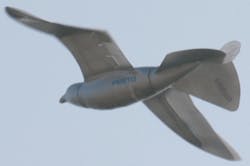Focus on Efficiency: Bird Flight Deciphered
Festo calls this technology the Bionic Learning Network, and it first exhibited the bird at the 2011 Hannover Trade Fair. As they explained to the assembled editors, “With SmartBird, engineers from Festo have succeeded in decoding the flight of birds, thus accomplishing a further breakthrough in automation technology... Festo is providing fresh impulse not only in factory automation, but also in process automation."
Efficiency criteria such as flexibility, low weight in relation to displaced mass, and energy consumption are Festo’s focus. “Nature shows in highly diverse ways how minimum consumption of energy can yield maximum performance.” said a company spokenman. “Festo learns from nature’s principles in order to transfer its strategy of efficiency to automation technology through bionics. Its projects demonstrate new technologies which made their implementation possible and are setting the pace in various fields, from safe automation and intelligent mechatronics solutions up to new drive and handling technologies, energy efficiency and lightweight construction.”
The key to understanding bird flight in order to replicate it in a mechatronic automation project includes two features: the active torsion of its wings, which provides the unique movement, and the fact that it dispenses with the use of additional lift devices.
SmartBird flies, glides and sails through the air just like its natural model. Its wings not only beat up and down, but also twist at specific angles. This is made possible by an active articulated torsional drive unit, which in combination with a complex control system makes for unprecedented efficiency in flight operation. Festo has thus succeeded for the first time in attaining an energy-efficient technical adaptation of this model from nature.
The Bionic Learning Network—a collaboration between Festo and universities, institutes and development companies—is an integral part of innovation processes at the company. The Bionic Learning Network also constitutes part of Festo’s commitment in the field of basic and advanced technical training.

